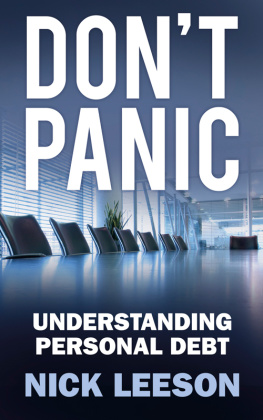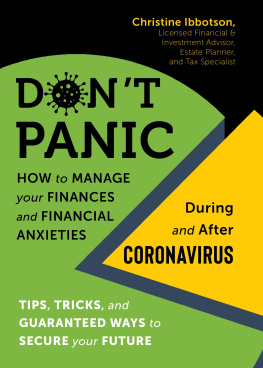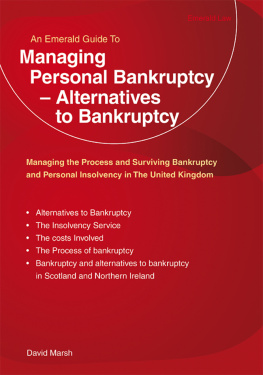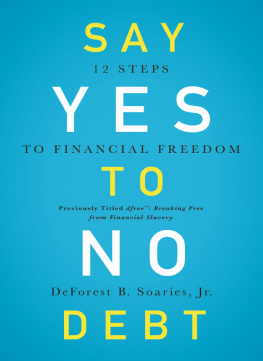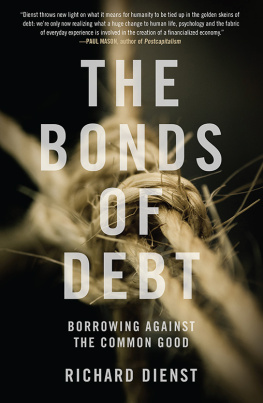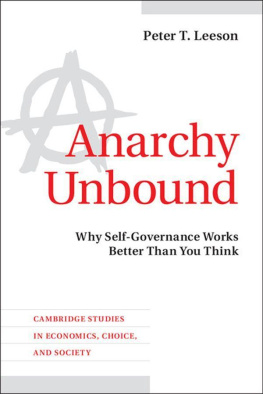
Contents
1
It was evident from the general tone of the whole party, that they had come to regard insolvency as the normal state of mankind, and the payment of debts as a disease that occasionally broke out.
Charles Dickens, Little Dorrit
I moved to Ireland in January 2003. At that time, Ireland was a land of unlimited opportunity, in which European Union money had kick-started a boom in the economy that could be seen everywhere you looked; huge improvements were being made to the infrastructure of the country, the Punt had recently been swapped for the Euro, interest rates were the lowest that they had ever been and falling further, and credit was available in abundance. There was a tangible sense that there was no end to the millions and a million ways to make them. And, of course, a lot of houses were being built. These factors combined to paint a picture of economic prosperity that was the envy of European nations. It sounds idyllic, and for many it was, but for each of those positives there was a negative lurking in the shadows.
Swapping the Punt for the Euro was, in retrospect, the first step in losing control over fiscal responsibility and direction. Low interest rates convinced everyone that they had the time to pay and that it only made sense to borrow. And when you did apply for credit, it was so readily available that the decision-making processes were not always as robust as they might have been.
The sum of those three situations was that the day of reckoning was never really far away. Nobody had any idea quite how calamitous the sequence of events would prove to be, or how damaging the impact would become, but it was always coming. We have all learned that to our cost.
Recent revelations have also compounded the widely held suspicions that some bankers were reserving a particular brand of contempt for the governments and regulators. Bonus time was always going to come around, so leverage up or stay at home. This was a party, and it was never, ever going to stop.
That rings a chord with me, I have to admit. I was out of control during my time in Singapore. I was continually buying myself time, postponing the realisation of the losses that were mounting in my illegal trading account, but as long as I had access to money and funding for my illegal positions, I could keep going.
More money was always available. The bank I worked for, Barings, would find some way of arranging it as they believed, like many of us, that we were on a gravy train that knew no end. They felt that they had stumbled on a golden goose that was making money hand over fist in Singapore and, as a result, keeping me happy and trading was at the top of the agenda.
Very few questions were ever asked when the coffers ran dry. More money was borrowed from Barclays and Citibank, their principal lenders at that time. Money was coming from the Head Office in London and the treasury department of Barings, and was readily available as long as I reported a healthy profit. There was very little control.
Eventually, though, the bank did run out of money. Barings was, in the scheme of things, only a small bank. Its capital base of 250 million was minimal in global banking terms, and by the end of 1994, the losses in my illegal account must have been getting close to 500 million, twice the capital base.
As long as the funds were available I kept going, in the increasingly forlorn hope that I would be able to turn the position around and get back to normality. From a high of 39,995, the Nikkei 225 Futures (the most widely used of the Japanese stock market indices) had fallen to half that value and the market was falling with increasing pace.
Barings Head Office finally had no more money to send, and the banks that were lending to them to facilitate my positions in Singapore had closed shop, unwilling to loan any more. My number really should have been up at that stage but, rather than ask difficult questions, the bank looked for new ways to find money. They went to the stock market and issued a bond for 100 million, which went exactly the same way as the rest, which was into my illegal trading account and out through the losses that were ballooning out of control. Eventually all the money Barings own, the loans from Barclays and Citibank and any bondholders involved was all hoovered up into the 862 million worth of losses, which ultimately signalled the collapse of the bank.
In part, the role played by the board and those responsible for running Barings bore similarities to those in charge at Anglo Irish Bank. They werent really worried where the money was coming from as long as the bank was able to continue. Over time, the attempts to raise funds got more and more desperate. The similarities to the situation do not end there. Lending was sometimes reckless in the extreme, controls failed to function and were sometimes brazenly ignored, regular audits failed to highlight the problems and systems could be overridden when they needed to be.
The markets that I used to trade in are often described as complex. I suppose it is a matter of opinion but the activity that sparked the major problems in Ireland, lending, is as simple as can be. The parameters are tried and tested over hundreds of years and, if adhered to, they generally work. In Ireland, during the decade before the property crash, those parameters were breached time after time after time, with brutal consequences.
As everyone knows, the Irish economy expanded rapidly during the Celtic Tiger years of 19942007. In part this was due to a low corporate tax rate and low European Central Bank interest rates as mentioned, but there was another set of systemic factors that created anomalies in the way the Irish State was governed. These included an extremely soft surveillance of banking supervision against the Basel Core Principals adopted in most other European nations, and the adoption of poor policies such as a corporate tax system that fostered non-tradable goods and services through the construction industry. The credit expansion that this resulted in was unrivalled, which then fuelled the property bubble that followed. This, in turn, started to experience problems from 2007 onwards, and these problems gathered pace throughout the ensuing global financial crisis and reached its zenith in September 2008 on the night the infamous guarantee was put in place.
In the period from 20042008, Irish banks foreign borrowings rose from 15 billion to 110 billion. The banks were lending long term to borrowers, principally the larger property developers, and borrowing themselves on a three-month roll-over basis. The properties that the loans were based upon would not typically be sold for several years so, when the property crisis hit and they could not be sold at all, due to massive over-supply and limited demand, the result was a classic mismatch of assets and liabilities. When government and banking officials met in September 2008 and decided to issue the bank guarantee, this was, of course, an attempt to stem the crisis and the hugely damaging uncertainty around the financial system. The banks were said to be illiquid (but not insolvent) by 4 billion. This turned out to be quite a significant underestimation.
The bill to bailout the banks was to eventually be astronomical.
Anglo Irish Bank was the first to fall. A boutique lender to builders and developers, the bank had made a succession of highly leveraged bets on the future of Irelands increasingly unsustainable property market, and its spectacular collapse made it the poster child across the world for banking profligacy and short-sightedness. The eventual bill to the Irish taxpayer was reported to be in excess of 29 billion.
Next page
